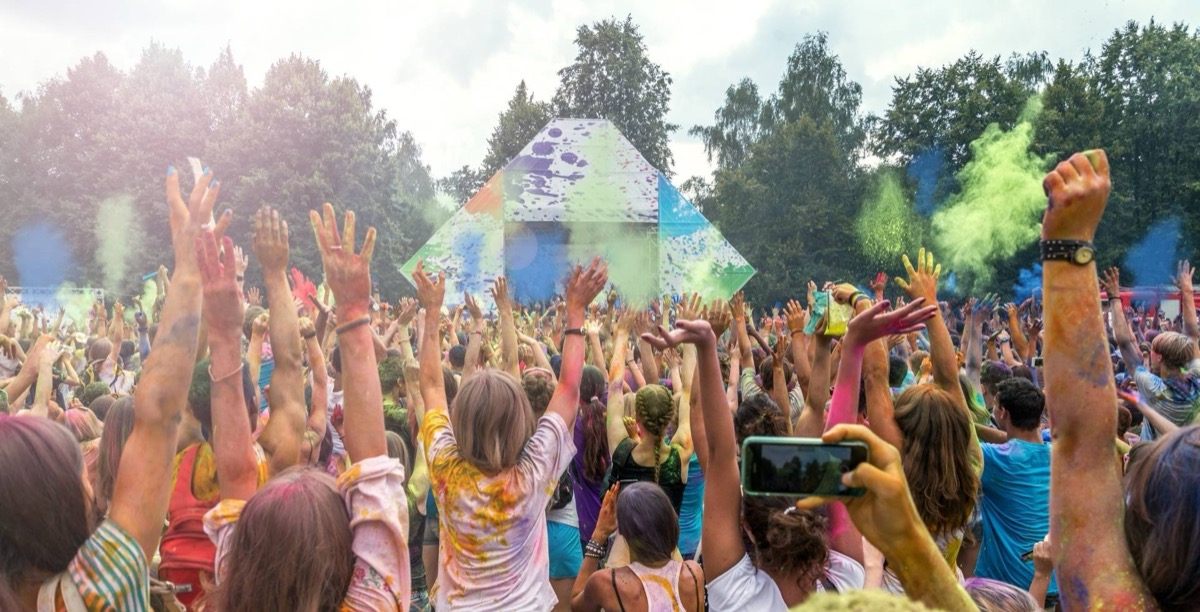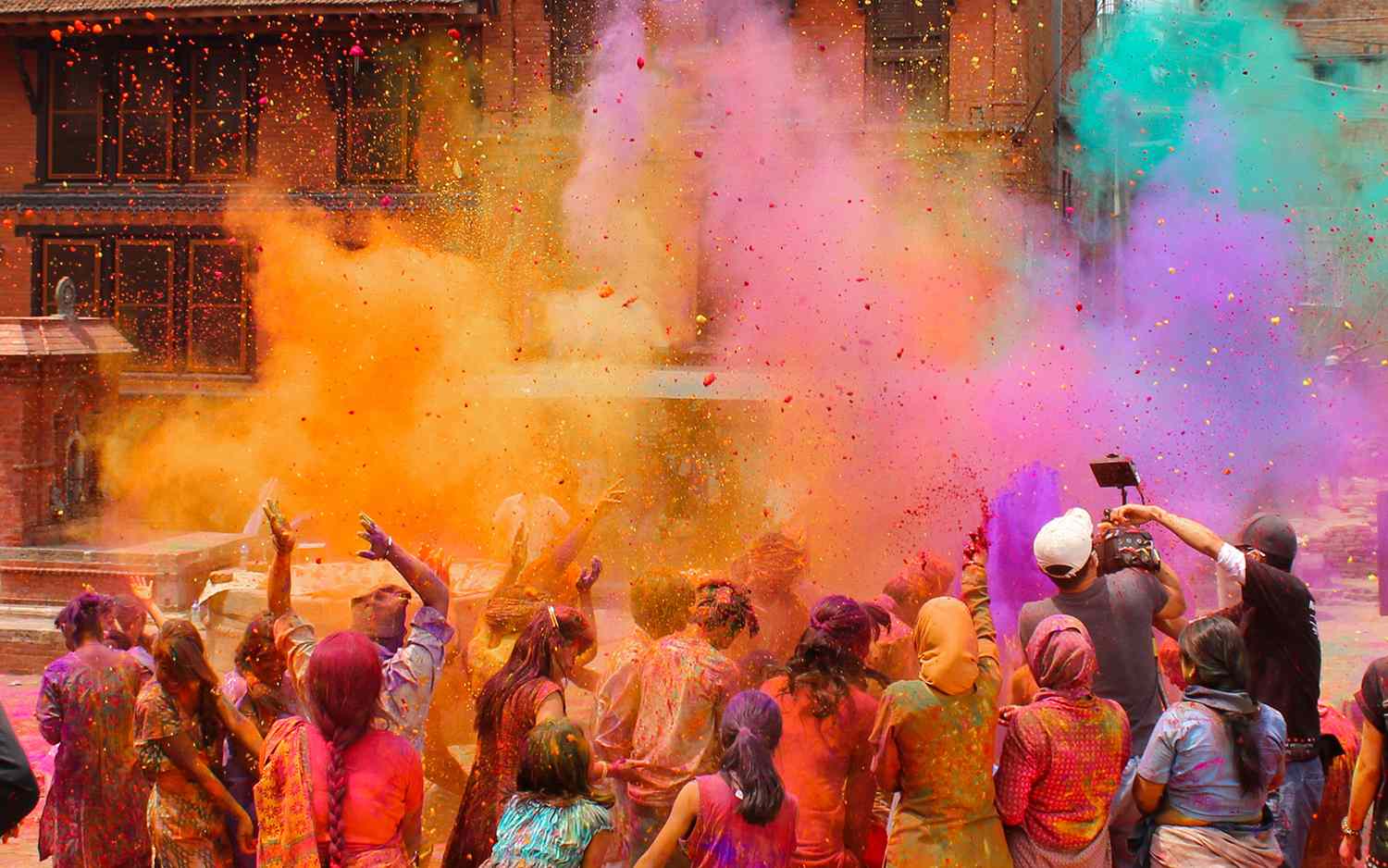Holi is classically hailed as the Festival of Colours; it is one of the best and most lively festivals held in Nepal. When spring comes, this country explodes with colors, laughter, music, and joy each year. Although the mainstream of Holi belongs to ancient Hindu traditions, it has been so widely accepted that it's not just sort of a religious event but a celebration that transcends borders, reaching across the common man. In Nepal, people enjoy Holi as if it were not an occasion for pouring colour powders and water balloons over each other but rather much more an expression of cultural richness and unity within the community.
Entering the streets of Nepal's Kathmandu or Pokhara or even a smaller town or village, one very clearly notices that the entire world turns into a living canvas. While colorful powders are thrown in every direction, there is whirlpool excitement with wonderful sounds of laughter, music, and singing filling the entire atmosphere. This is the flavor of the country, the warmth, the people therein, and the traditions that speak Nepal.

The Significance of Holi
Culture and spirituality are felt with depth by Holi, and each aspect symbolizes very important themes. It reverberates the good over evil ideas, which are embedded in the mythology of Prahlad and Holika. The aunt of Prahlad, the most devoted worshipper of Lord Vishnu, tried to kill him according to the mythology; however, instead, she was burned in the fire. This is symbolized by a Holika Dahan bonfire that destroys evil and makes a victor righteous. Holi heralds the advent of spring- renewal for life, the end of winter, and fertility. The vivid colors of this festival embody the rejuvenation of nature and are representative of the hope and vitality spring brings.
In addition, Holi also remembers the divine love between Lord Krishna and Radha, especially prevalent in regions such as Vrindavan and Mathura. During the festivities, Krishna's playful act of coloring Radha's face is reenacted, symbolizing the loving tie between the human soul and the divine. Thus, Holi is a festival of unity by breaking social barriers and adding inclusivity. Historically, it has been the time of all people, including the richest to the poorest, to mingle with each other, forgive whichever ways they may have been aggrieved, and celebrate without distinction.
In the end, this is a festival of joy and freedom that encourages people to renounce their historical conflicts so that they can be part of the new beginning. Finally, a renewed vigor in celebrating life can be witnessed.
Historical Background
Holi, one of the oldest grand festivals of the Hindus, is mostly of a mythological origin. If one must see the parameters under such a purification as would usher good towards people's hearts, such as indeed the story regarding that of Prahlad and Holika, evil was vanquished. According to the myth, Holika was a demoness who tried burning her brother’s son, Prahlad, by supposedly taking away all his protections; however, he survived that fire of his extreme devotion to Lord Vishnu, and Holika burnt herself.
This is then what Holika Dahan is all about making bonfires on the eve of Holi and the deed is symbolizing not only the destruction of evil but also renewal in the good sense for humanity. This festival has some other association with Lord Krishna and Radha, whom we hear of very playful colors being thrown on them by Krishna while he celebrated this festival with gopis, the songkrishta. Thus, today all those colorful celebrations are quite famous.
Traditionally, Holi was celebrated with the end of winter and the beginning of plentiful harvest seasons, the ending of winter's dormitory hibernation state. But, it has been evolving for years to represent the purest kind of joy in creating unity among all human beings, demolishing lifetimes of social barriers, and closing different communities into one. Holi thus turned times of forgiveness, into an enabler for collective reconciliation, and indulgence in the fraternity of society where individuals were colored from different castes and backgrounds.
Today it is observed around the world bringing the celebration of life beyond religions and cultures in a colorful expression of love and joy.
The Essence of Holi

Holi is always celebratory, rejoicing, and renewing. Brightly coloured in its own purest expression, Holi takes into account the very colourful moments in one's life, transcending all barriers of religion and culture. The coming of spring is marked by this joyous festival, bringing with it the promise of renewal and new lives. Nature itself gets buzzed and bursts to life with cherubic colors. More than being just all about colored powders thrown at one another, Holi also encourages letting go of all past conflicts, forgiving, coming together again in spirit, and having fun. This festival is not just an invitation to all; but also open to all walking the same path of life, without regard to caste or class or other kind of discrimination.
Holi signifies, as in most cases, the triumph of good over evil: for instance, in the story of Prahlad, Hiranyakshyap, and Holika. The ill-fated fire that would engulf Holika symbolizes the triumph of virtue over baseness in humans. More than that, Holi embodies the divine love of Lord Krishna and Radha, a mark of playfulness denoting an eternal bond between the human soul and the divine. One might also consider it as a time of observing mirth and renewal and spreading joy to make a community lose joy, laughter, and love in a rather carefree atmosphere. Life tends to get prettier while living in the moment.
2025 Holi in Nepal

In Nepal, Holi in 2025 will be celebrated on the 13th and 14th of March. The celebrations will be held on the 13th in hilly areas including Kathmandu and other towns, while the festivities will proceed on the 14th in Terai. Falling in the spring, Holi is a festival of color and togetherness. Gulal (colored powder) gets hurled across long distances, water gets splashed, and white clothes covered in bright jubilant colours are dressed by revelers.
Public spaces are turned into focal points of celebration over a few days. People young and old join the revelry, along with sharing with friends and family, traditional foods and sweets. This is complemented by cultural performances of music and dance. Kathmandu, Pokhara, and Bhaktapur are particularly vibrant during this time, offering an unmatched experience for both locals and visitors alike.
Holi Beyond the Colors: A Festival of Connection
Holi, which is referred to as the festival of colors, is not only about an extravagant display of colors and merry-making. It is an inward journey within the folds of one's soul where people intermingle with colour, forgetting who is upon what platform or with what differences. Holi becomes a personal celebration within humans when they decide to interact and throw colours at each other's faces to erase any malicious past grievances or divides left by barriers of caste, class, or age. It is this gesture of throwing colours that signifies the oneness in the world as people gather for togetherness, having different pathways of life to step into the pure joy of being alive and celebrating their bonds.
Socially, this festival also has its spiritual depths, as it deals with renewal, love, and forgiveness. The occasion so denotes the inner self, laying aside all grudge-holding and restraint from what has to be unaided freedom and a new beginning. Bringing communities together under shades of laughter, chore, and festivities. Holi, by its connection with Hindu tradition, upholds constancy in age-old myths regarding the supremacy of good over evil, the earthly love Krishna had toward Radha, and the celebration of renewal in nature.
However, it has the universal message of celebrations: it is for bringing people together in a relationship and for being the most pure form of joy. No matter where they are, at home, with friends, or with total strangers, it teaches them about compassion, cohesiveness, and the charm of human relationships while celebrating.
Holi in the Streets: The Festival in Action
Holi in the street presents a splendid sight of energy, joy, and colors so magical that they turn cities and villages into vibrant, frenzied, and beautiful canvases. But as the festival goes along, the air thickens with laughter, music, and clanging drums, while colored powders fill that surreal magic of the atmosphere.
In Nepal, it becomes a playground of streets where everyone, men, women, young, and old just devotes everything to this celebration. The festivities begin at the break of dawn, though, with groups of people ready with their pichkaris and bags of colored powders, prepared to spread cheer. The whole scene is contagious- friends, neighbors, and even strangers happily color together and the joyous bond created from it. In many neighborhoods, neighbors stretch sweets, sing along the lines of traditional Holi songs, and dance to the beat of dholaks (drums) and other local instruments. This occasion is not just for merriment and joy but fosters community among people because it brings together family and friends while urging the spirit of forgiveness in mending broken relationships.
What gives a little extra significance to Holi in the streets, however, is its peculiar sense of inclusivity. Strikingly rich or very poor, young or old, Nepali or foreign become conveniently intertwined in the most joyous use. Castes, social statuses, and differences fade as the colored powders make a level field for all participants. Strangers become brothers in arms, and the loud cacophony of the celebration beckons all to feel freedom and enjoyment in letting go. Colors that remind one of renewal, hope, or celebration become more than mere fun traditions to forget-they remind one visually of the shared human experience and life beauty.
Holi in the streets is not just the festival of colors; it is a festival of connections in which humanity comes together in laughter, music, and the joy of being themselves. It's taking time to celebrate life, forget the past, and become one with all in shared love, happiness, and community. Be it in a colorful water fight, within the noise and the team spirit, or just the joyous ambiance itself, Holi on the streets is, without a doubt, one unique experience that captures the true spirit of the festival itself.
Regional Variations of Holi in Nepal

There are several regional varieties of Holi celebrations in Nepal, contributing their flavor to the festival. The celebrations in the Kathmandu Valley are big, merry, and colourful; streets are filled with sprays of colored powder, music, and dance. Large numbers of people gather in public spaces across Kathmandu, Bhaktapur, and Patan to celebrate with merriment. In Kathmandu, the festivities are highlighted by processions and street festivals like "Bisket Jatra," and thus the atmosphere becomes more joyful with much fun and color. The Kathmandu celebrations of Holi not only provide an occasion for joy, thrilling games, feasting delicious food, and dancing but also for hanging around with friends, strengthening bonds, and associating with the bright cultural practices of the valley.
In the southern Terai area bordering India, Holi is louder and livelier. Influenced by Indian customs, a few water wars take place here with water balloons and pichkaris or water guns. The loud, almost larger-than-life celebrations usually include massive community gatherings where music, dance, and throwing color dominate the day. Lots of fun intermixed with a bit of playful rivalry gives Holi the liveliness and energy for which it is popular in the Terai.
In the mountain and hill regions of Nepal, the Holi celebration takes a quieter and more intimate form. The celebrations here usually involve calmer community gatherings where families and friends get together, and take part in traditional rituals, dictated songs, and dances. On the outside, it may appear solemn in many places, perhaps with fewer public celebrations; however, the spirit of Holi is far from soberness, with emphasis put on family ties and appeasing Mother Nature for her graceful renewal. In Pokhara, Gorkha, and Rupandehi, these combine to celebrate Holi among people of varying ethnic and cultural backgrounds coming together in harmony, thus forming a true reflection of the rich cultural fabric that is Nepal.
Celebration Day in Activities
An exuberant, colorful, and community-spirited day, Holi in Nepal is filled with activities throughout the day. The festivities generally begin in the early morning hours and continue through the evening hours. Some of the major activities that characterize the celebration of Holi are related as follows: Holika Dahan: In many areas all over Nepal, Holika Dahan is celebrated the evening before Holi. This bonfire symbolizes the burning away of evil as derived from the legend of Prahlad and Holika. People gather around the bonfire singing songs and dancing, celebrating the victory of good over evil. This ritual is an intrinsic spiritual and cultural part of Holi celebrations.
- Colour Fights and Water Games: The day of Holi finds the streets and parks filled with colour. Ornaments made of colored powders (gulal) are dusted on each other; water balloons are thrown; and colored water is sprayed using pichkaris (water guns). This harmless merry-making spirit stands for joy, unity, and breaking down class barriers. People of all ages, including children and elders, are frequently seen partaking in the color-filled fun.
- Music and Dance: Music is, of course, at the heart of the Holi celebration. The singing of traditional Holi songs becomes in poor sync with the beats of the competing dholaks (drums). Groups perform folk dances, such as Devi dance or Garba dance in the major homelands of Kathmandu and Pokhara, while contemporary songs are loud all the time. The dhol and dance beats ringing in the air keep adrenaline pumping for the whole day.
- Visiting Relatives and Friends: Any Holiday is a time for social gatherings and strengthening bonds with family, friends, or a neighbor. People go visit each other's houses and exchange lots of sweets or special festive goodies like gujiya and thandai (a special Holi drink made with milk, nuts, and spices). It is the time for compromise, where bygones are bygones and everybody comes back together, laughing and forgetting everything.
- Collective Celebrations and Festivals: In some regions, community celebrations occur at temples or open spaces where masses gather for celebrations. This kind of community celebration usually entertains choreographers, dancers, musicians, and even street parades, all of which make for a fun experience in places like Kathmandu, Bhaktapur, and Pokhara.
- Traditional Rituals and Prayers: While most of the activities during Holi are meant to celebrate and have fun, many also embrace traditional rituals. There are visits to temples, prayers, and religious rituals performed to receive blessings through the upcoming year. In places like Lumbini, which carries a greater spiritual atmosphere, the day also combines prayer and spiritual assemblies amidst merry-making.
- Food and Sweets: Food and sweets are the ones governing Holi. Families bring out special items like pani puri, kachori, and gujiya (a sweet dumpling with a filling of dry fruits and coconut). Thandai, a milk-based drink consumed during festivals, is sometimes offered in a bhang (cannabis) version for cheer.
Traditional Foods
Food plays a vital role in Holi celebrations in Nepal, and different preparations of traditional food are made. The festive foods portray the season and cultural significance of the festival, which comes bursting with flavor and finesse. This list covers a few well-known traditional foods during Holi.
- Gujiya: Gujiya is regarded as one of the most commonly known foods associated with Holi, made from sweet dumplings filled with khoya (mawa), coconut, and some dry fruits. These deep-fried pastries are rolled in powdered sugar and shared among families during the festival celebrations. Gujiya has a place in every Nepali home during the time of Holi.
- Pani Puri: Unconventionally known as street food, pani puri has always been famous: for immersion in spicy-sour-sweet water (pani) or filled with mashed potatoes in crispy purees (fried dough balls). Always a Holi hit, sharing increases its fun factor.
- Thandai: Thandai is a drink of milk, almonds, saffron, and spices like cardamom and pepper. Bhanga (cannabis) is added sometimes for that extra celebratory-relaxed twist. This cooling and delicious drink is liked by many during Holi as a remedy for the heat.
- Kachori: An all-time Holi treat, Kachori is another one of the traditional dishes comprising deep-fried pastries filled with spicy lentils or potatoes. They make a delicious savory snack with crunchiness on the outside and softness on the inside, nice to balance all the sweet dishes that are customarily served at the festival. Usually accompanied by spicy chutneys or yogurt, Kachoris are simply addictive.
- Dahi Vada: Dahi vada has always been a lovely Holi snack, made of soft lentil dumplings fried, soaked in yogurt, and sprinkled with spiced powders, like cumin and coriander, and tamarind chutney-it's just perfect to balance the sweetness of the other dishes.
- Sweets and Mithai: Different kinds of sweets, from barfis to ladoos to jalebis, are made during Holi and sent off among close ones. These sugary items are typically home-prepared and represent the festival's spirit and sweetness. They are exchanged as tokens of goodwill and affection.
- Bhaat (Rice): In certain areas of the country, Holi Lunch serves Bhaat (rice) in the traditional form with Dal (lentil soup) sabzi (vegetable curry), and pickles. This rather elaborate meal is meant to be consumed in families, emphasizing socializing and enjoying a meal together.
- Samosa: The spicy samosa filling of potato and peas blended and deep-fried to a crisp golden brown; samosas are usually served during Holi. This savory snack is fun to pop in the mouth while drenching others with colors during the celebration.
Though a riot of colors, Holi in Nepal is a celebration of unity, joy, and renewal. It is a time to come together and celebrate love and forgiveness and to welcome spring. With food, local traditions, and a spirit of togetherness, Holi brings in the feeling of inclusiveness. The festival strengthens the bonds among communities wherever it is celebrated-from urban extensions to deep countryside areas. Taking into cognizance the deep cultural and spiritual significance conferred by this festival makes Holi one of the most celebrated festivals in Nepal.
FAQs
When does Holi fall in Nepal?
Holi celebrates the full moon of Phalguna, the month of the Hindu lunar calendar, which usually falls in March. The nearer date will vary, depending on the lunar calendar of that year.
What is the significance of Holi?
Holi is celebrated as the myth associated with the victory of good over evil, as Prahlad and Holika signify. Also, it is associated with ushering in the spring, which is the season of rejuvenation or growth and relates to the divine love of Lord Krishna and Radha.
What are the customary foods for Holi in Nepal?
There are many traditional foods for Holi, like gujiya, pani puri, kachori, thandai (occasionally laced with bhang), dahi vada, and a few sweets such as jalebi and barfi that are consumed during the holidays.
Is Holi an exclusively Hindu festival in Nepal?
Holi is celebrated especially by Hindus, but not limited to that for other people in Nepal from different backgrounds and religions partake in this festival. It is a festival where everybody becomes a part and parcel of the joy and togetherness that it brings to mankind.
How do people observe Holi in different places in Nepal?
It varies from region to region as Kathmandu and Pokhara have many public events with music, dance, and culminating in color-throwing on this festive day. The Terai regions have more lively water fights and public gatherings, while celebrations in the mountains are mostly private or family gatherings.
What is Holika Dahan?
Holika Dahan is a ritual that is done on the night before Holi, known as the ceremonial burning using a bonfire, which makes destruction to evil and victory to good. Gather people around the fire to sing, dance, and celebrate this cultural and religious tenure.
Can foreign tourists take part in Holi for the time being in Nepal?
Yes, most likely, tourists might be allowed to celebrate the Holi festival within the Nepalese community. This is an inclusive joy festival, where outsiders can also take part, especially in the big cities that conduct public events in cities.
What is the significance of colors in Holi?
Colors are symbols of life vibrancy, a sign of spring onset, and renewal with nature. In this context, throwing colored powders at one another represents the spirit of joy and unity while breaking down social barriers.

